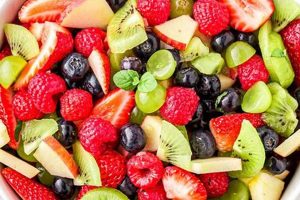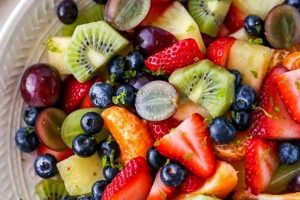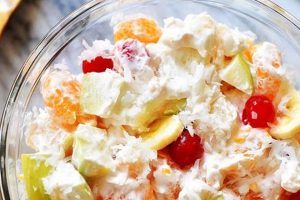Combinations of fresh, seasonal fruits create vibrant and flavorful dishes ideal for warmer weather. For instance, a mixture of strawberries, blueberries, kiwi, and oranges offers a refreshing blend of sweet and tart flavors, showcasing the bounty of spring produce. Such culinary creations provide a light and healthy option, perfect for picnics, brunches, or a simple dessert.
Light and refreshing dishes featuring seasonal produce offer numerous nutritional benefits, providing essential vitamins, minerals, and antioxidants. Historically, the concept of combining various fruits has evolved alongside culinary traditions and the availability of diverse ingredients. Access to fresh produce during springtime allows for the creation of dishes that celebrate the season’s vibrant flavors and contribute to a healthy diet.
This exploration will delve into various aspects of creating these seasonal delights, including selecting the best produce, balancing flavor profiles, and incorporating complementary ingredients like herbs, spices, and light dressings.
Tips for Creating Spring Fruit Salads
Creating a delicious and visually appealing spring fruit salad involves careful selection of ingredients and attention to detail. The following tips offer guidance for crafting the perfect springtime treat.
Tip 1: Prioritize Seasonal Produce. Selecting fruits at their peak ripeness ensures optimal flavor and texture. Springtime favorites include strawberries, raspberries, blueberries, kiwi, apricots, and cherries. Choosing in-season options guarantees the freshest, most vibrant ingredients.
Tip 2: Balance Sweet and Tart Flavors. A harmonious blend of sweetness and acidity elevates the overall taste experience. Combining fruits like sweet berries with tart citrus fruits creates a balanced and refreshing flavor profile.
Tip 3: Consider Textural Variety. Incorporating fruits with diverse textures adds complexity and interest. Combining soft fruits like berries with firmer options like apples or grapes provides a delightful textural contrast.
Tip 4: Enhance with Herbs and Spices. Fresh mint, basil, or a touch of ginger can elevate the flavor profile of a fruit salad. A light sprinkle of cinnamon adds warmth and complexity, particularly when paired with stone fruits.
Tip 5: Choose a Light Dressing (Optional). A simple dressing can complement the natural flavors of the fruit. A squeeze of citrus juice, a drizzle of honey, or a light vinaigrette can enhance the overall taste without overpowering the delicate flavors of the fruit.
Tip 6: Prepare and Store Properly. To prevent browning, delicate fruits like apples and bananas should be added just before serving. Storing prepared fruit salad in an airtight container in the refrigerator helps maintain freshness.
Tip 7: Presentation Matters. Arrange the fruit salad attractively in a bowl or on a platter. Consider garnishing with edible flowers or a sprig of mint for an elegant touch.
By following these tips, one can craft a delightful and refreshing fruit salad that showcases the best of spring’s bounty. The combination of fresh, seasonal ingredients, balanced flavors, and thoughtful presentation results in a dish that is both healthy and visually appealing.
These guidelines offer a starting point for creating diverse and flavorful spring fruit salads, allowing for endless variations based on personal preferences and available ingredients. The next section will explore specific recipe examples.
1. Seasonal Fruit Selection
Seasonal fruit selection forms the foundation of successful spring fruit salad recipes. Utilizing produce at its peak ripeness guarantees optimal flavor, texture, and nutritional value, resulting in a superior culinary experience. This section explores key facets of selecting seasonal fruits for spring salads.
- Availability and Peak Season
Different fruits reach peak ripeness at various points throughout spring. Strawberries, for example, are typically abundant in early spring, while cherries and apricots become more readily available later in the season. Understanding these seasonal variations allows for informed selection and ensures access to the freshest, most flavorful produce. Consulting local farmers’ markets can provide insight into regional availability and peak seasons.
- Flavor Profiles and Combinations
Spring fruits offer a diverse range of flavor profiles, from the sweet tang of berries to the subtle tartness of rhubarb. Considering these distinct flavors is crucial when crafting a balanced and harmonious fruit salad. Combining fruits with complementary flavor profiles, such as pairing sweet strawberries with tart raspberries or tangy kiwi, enhances the overall taste experience. Experimentation with different combinations allows for the creation of unique and exciting flavor profiles.
- Texture and Visual Appeal
The texture of individual fruits plays a significant role in the overall appeal of a fruit salad. Incorporating a variety of textures, such as combining soft berries with firmer fruits like melon or apples, creates a more dynamic and enjoyable sensory experience. Furthermore, the vibrant colors of spring fruits contribute to the visual appeal of the dish. Selecting fruits with diverse colors enhances the presentation and makes the salad more enticing.
- Nutritional Value and Health Benefits
Seasonal fruits offer a wealth of vitamins, minerals, and antioxidants. Choosing a variety of in-season fruits ensures a diverse intake of nutrients. Spring fruits, in particular, are rich in Vitamin C, which supports immune function, and fiber, which promotes digestive health. Incorporating these nutrient-rich fruits into a salad contributes to a balanced and healthy diet.
By carefully considering these facets of seasonal fruit selection, one can create spring fruit salads that are not only delicious and visually appealing but also nutritionally beneficial. Prioritizing in-season produce ensures access to the freshest and most flavorful fruits, resulting in a dish that truly captures the essence of spring.
2. Flavor Balancing (Sweet/Tart)
Flavor balancing, specifically the interplay between sweet and tart components, constitutes a critical element in crafting successful spring fruit salads. A harmonious balance elevates these dishes beyond simple mixtures of fruit, transforming them into complex and refreshing culinary experiences. This balance prevents overwhelming sweetness and adds depth of flavor.
- The Role of Acidity
Tartness, derived from acidic fruits, provides a crucial counterpoint to the sweetness of other fruits. This acidity brightens the overall flavor profile and prevents the salad from becoming cloyingly sweet. Lemon or lime juice, tart berries like raspberries, and slightly underripe fruits contribute necessary acidity. The strategic use of these tart elements enhances the sweetness of other components, creating a dynamic interplay.
- Balancing Sweetness Levels
Different fruits possess varying degrees of sweetness. Balancing these levels ensures a harmonious blend. Overly sweet combinations can be monotonous, while insufficient sweetness can result in a bland or tart salad. Incorporating a range of fruitsfrom mildly sweet melons to intensely sweet berriesallows for careful calibration of overall sweetness. For example, balancing the sweetness of ripe strawberries with the milder sweetness of honeydew melon creates a more nuanced flavor profile.
- Enhancing Flavor with Herbs and Spices
Herbs and spices can further refine the balance between sweet and tart flavors. Mint, for instance, adds a refreshing coolness that complements the sweetness of fruits while also enhancing their tartness. A touch of ginger can add a subtle warmth and complexity, particularly when paired with stone fruits like peaches or apricots. These additions create multi-layered flavor experiences that extend beyond simple sweet and tart combinations.
- The Impact of Dressings
Dressings, while optional, offer another avenue for flavor balancing. A light vinaigrette with a touch of acidity can enhance the tartness of the fruit salad, while a drizzle of honey can add a subtle sweetness. The choice of dressing should complement the existing flavors of the fruit, further refining the balance rather than masking the natural sweetness and tartness.
Careful consideration of these elements ensures a well-balanced and flavorful spring fruit salad. The interplay of sweet and tart flavors, enhanced by complementary ingredients and mindful dressing choices, results in a dish that is both refreshing and complex, showcasing the best of springtime produce.
3. Textural Variety
Textural variety significantly contributes to the overall enjoyment of spring fruit salads. A combination of textures elevates these dishes beyond simple sweetness, offering a more engaging and satisfying sensory experience. This involves incorporating fruits with diverse textures, creating a dynamic interplay within each bite.
- Soft Fruits
Soft fruits, such as berries and ripe bananas, provide a delicate sweetness and a smooth, almost creamy texture. These fruits often release juices, contributing to the overall moisture and flavor of the salad. Examples include strawberries, raspberries, blueberries, and blackberries. Their softness contrasts with firmer fruits, creating a balanced textural profile. Overripe soft fruits should be avoided as they can become mushy and detract from the overall texture.
- Firm Fruits
Firm fruits like apples, grapes, and melon offer a contrasting texture to softer fruits. Their crispness and density provide a satisfying bite and prevent the salad from becoming overly soft. Examples include diced apples, halved grapes, and cubed cantaloupe. These firmer fruits retain their shape well, contributing to the visual appeal and structural integrity of the salad.
- Crunchy Elements
Incorporating crunchy elements adds another layer of textural complexity. Nuts, seeds, or even toasted coconut flakes can provide a satisfying crunch that contrasts with the softer and firmer fruits. Examples include chopped almonds, sunflower seeds, or toasted pecans. These additions not only enhance the textural variety but also contribute to the nutritional value and flavor profile of the salad.
- Balancing Textures
The key to successful textural variety lies in achieving a balance. Too many soft fruits can result in a mushy salad, while an overabundance of firm fruits can make it feel dense and heavy. A thoughtful combination of soft, firm, and crunchy elements ensures a dynamic and enjoyable eating experience. Consider the proportions of each type of fruit and the size of the pieces when assembling the salad to achieve optimal textural balance.
The interplay of textures in a spring fruit salad contributes significantly to its appeal. A well-balanced combination of soft, firm, and crunchy elements enhances the sensory experience, creating a dish that is both refreshing and satisfying. This attention to texture elevates the fruit salad from a simple assortment of ingredients to a more complex and enjoyable culinary creation.
4. Complementary Ingredients
Complementary ingredients enhance the flavor profile and overall appeal of spring fruit salads. These additions, while not the primary focus, play a crucial role in elevating the dish beyond a simple mixture of fruits. Careful selection and application of complementary ingredients contribute depth, complexity, and balance, transforming the sensory experience.
Herbs, spices, and zests offer aromatic complexity. Fresh mint, for instance, provides a cooling counterpoint to the sweetness of berries, while a touch of grated ginger adds warmth and a subtle spice. Citrus zest introduces bright, vibrant notes. Nuts and seeds contribute textural contrast and nutritional value. Toasted slivered almonds offer a satisfying crunch, while chia seeds provide a subtle nutty flavor and boost the omega-3 content. A light drizzle of honey or maple syrup enhances sweetness while a squeeze of citrus juice introduces a balancing tartness. These ingredients interact synergistically with the fruits, creating a more nuanced and sophisticated flavor profile. For example, a strawberry-rhubarb salad benefits from the addition of chopped mint and a drizzle of balsamic glaze, the mint accentuating the sweetness of the berries while the balsamic glaze complements the tartness of the rhubarb.
Understanding the role of complementary ingredients is essential for crafting well-balanced and flavorful spring fruit salads. These additions provide depth, complexity, and textural contrast, enhancing the overall sensory experience. The judicious use of herbs, spices, zests, nuts, seeds, and light dressings elevates the dish, showcasing the versatility of spring fruits and transforming a simple combination into a more sophisticated culinary creation. Overuse, however, can mask the delicate flavors of the fresh produce; restraint and balance remain key considerations.
5. Presentation and Serving
Presentation and serving significantly influence the perceived appeal and enjoyment of spring fruit salads. Visual appeal stimulates appetite, while appropriate serving techniques maintain the quality and freshness of the delicate ingredients. Consideration of these aspects elevates the dining experience, transforming a simple fruit salad into a visually captivating and palate-pleasing culinary creation. A thoughtfully arranged salad encourages consumption and appreciation of the diverse flavors and textures.
Visual appeal encompasses factors such as color arrangement, the use of contrasting shapes and sizes of fruit pieces, and the incorporation of garnishes. A vibrant array of colorful fruits arranged in a visually engaging manner enhances the perceived freshness and flavor. Garnishes, such as fresh mint sprigs, edible flowers, or a light dusting of powdered sugar, add an element of elegance and sophistication. Serving temperature also plays a crucial role; a chilled fruit salad offers a refreshing contrast to warmer ambient temperatures, particularly during the spring season. For instance, a spring fruit salad featuring vibrant berries, melon balls, and star-shaped kiwi slices, garnished with fresh mint and served in chilled glass bowls, offers a more enticing and refreshing experience compared to a haphazardly arranged mixture served at room temperature.
Effective presentation and serving techniques contribute significantly to the overall enjoyment of spring fruit salads. Visual appeal enhances the sensory experience, encouraging consumption and appreciation of the fresh, seasonal flavors. Appropriate serving methods, including temperature control and mindful arrangement, preserve the quality and freshness of the ingredients, ensuring an optimal culinary experience. These considerations elevate the fruit salad from a simple dish to a more sophisticated and satisfying culinary creation. Neglecting these aspects can diminish the perceived value and enjoyment, regardless of the quality of the ingredients themselves.
6. Recipe Variations
Recipe variations constitute a significant aspect of spring fruit salads, reflecting the versatility of seasonal produce and accommodating diverse palates. The availability of various spring fruits allows for a wide range of flavor and texture combinations. This adaptability ensures that recipes can be tailored to individual preferences, dietary restrictions, and available ingredients. The inherent flexibility within the basic concept of a fruit salad provides a foundation for creative exploration, resulting in unique and personalized culinary experiences. For example, a base recipe featuring strawberries and blueberries can be adapted to include other seasonal fruits like kiwi or apricots, expanding the flavor profile and nutritional value. Dietary adaptations might involve substituting honey with a sugar alternative or incorporating specific fruits based on allergy restrictions. The ability to modify recipes based on ingredient availability ensures that seasonal produce can be utilized effectively, minimizing waste and maximizing freshness.
This adaptability extends beyond simple ingredient substitutions. Variations can also incorporate different preparation techniques, such as grilling or roasting certain fruits to enhance their sweetness and add depth of flavor. The inclusion of complementary ingredients like herbs, spices, or nuts provides further opportunities for customization, creating unique flavor profiles tailored to individual preferences. For example, grilling pineapple and peaches before adding them to a salad with berries and mint introduces a smoky sweetness and textural complexity. Similarly, incorporating toasted pecans or a sprinkle of chili flakes adds contrasting textures and unexpected flavor dimensions.
Understanding the potential for recipe variation within the context of spring fruit salads empowers culinary creativity and ensures adaptability. This flexibility accommodates individual dietary needs, ingredient availability, and personal preferences, maximizing the enjoyment and utilization of seasonal produce. Ultimately, recipe variations celebrate the versatility of spring fruits and contribute to a more diverse and personalized culinary landscape. This adaptability promotes exploration and discovery within a seemingly simple dish, transforming it into a canvas for culinary expression.
7. Storage and Freshness
Maintaining optimal freshness represents a crucial aspect of crafting appealing and flavorful spring fruit salads. Improper storage can lead to undesirable changes in texture, flavor, and overall quality, diminishing the intended culinary experience. Understanding appropriate storage techniques preserves the vibrant flavors, crisp textures, and nutritional value of the fresh, seasonal ingredients essential to these dishes. Effective storage practices safeguard the investment of time and resources, ensuring that the final product meets expectations for both aesthetic appeal and palatability.
- Preventing Enzymatic Browning
Enzymatic browning, a chemical reaction triggered by exposure to air, affects certain fruits like apples, bananas, and peaches, resulting in discoloration and off-flavors. Limiting air exposure through techniques like coating cut surfaces with lemon juice or storing the fruit in airtight containers helps mitigate this process. This preservation of visual appeal and flavor integrity is particularly critical in fruit salads where the natural colors and fresh tastes of the ingredients are central to the dish’s desirability. For instance, preventing browning in sliced apples maintains the salad’s vibrant appearance and prevents the development of unpleasant flavors.
- Temperature Control
Maintaining appropriate temperature plays a vital role in preserving the freshness and quality of spring fruit salads. Refrigeration slows down enzymatic activity and microbial growth, extending shelf life. Storing prepared fruit salads at temperatures between 34F and 40F (1C and 4C) inhibits spoilage and maintains optimal texture and flavor. However, excessively cold temperatures can damage delicate fruits like berries. Avoiding temperature fluctuations further safeguards quality, preventing undesirable changes in texture and flavor. Storing the salad in the coldest part of the refrigerator, away from the door, helps maintain a consistent temperature.
- Storage Containers
Appropriate storage containers contribute significantly to preserving freshness. Airtight containers minimize air exposure, reducing oxidation and preventing the absorption of unwanted odors from other foods in the refrigerator. Using containers made of inert materials like glass or food-grade plastic prevents chemical reactions that can affect flavor. Properly sealed containers also maintain the desired humidity level, preventing the fruit from drying out or becoming overly moist, thus preserving texture. For instance, storing a fruit salad in a tightly sealed glass container maintains its freshness and prevents it from absorbing odors from other refrigerated items.
- Preparation Timing
Strategic preparation timing optimizes freshness. Preparing the fruit salad as close to serving time as possible minimizes the duration of exposure to air and temperature fluctuations. Delaying the addition of easily bruised or browned fruits like bananas or avocados until just before serving preserves their optimal texture and appearance. This practice ensures that the salad is presented at its peak freshness, maximizing visual appeal and flavor. Pre-cutting certain fruits and storing them separately until assembly also helps maintain individual textures and flavors.
Implementing these storage strategies ensures that spring fruit salads retain their vibrant colors, fresh flavors, and desirable textures. These practices directly impact the overall quality and enjoyment of the dish, highlighting the importance of proper storage in maximizing the culinary experience. By prioritizing these considerations, one can fully appreciate the delicate flavors and vibrant qualities of seasonal spring fruits, transforming a simple mixture into a truly delightful culinary creation. Neglecting these aspects can compromise the intended freshness and flavor, diminishing the overall appeal and enjoyment of the dish.
Frequently Asked Questions
This section addresses common inquiries regarding spring fruit salad preparation and storage, offering practical guidance for achieving optimal results.
Question 1: How can browning be prevented in cut fruits?
Coating susceptible fruits like apples and bananas with lemon juice or an ascorbic acid solution creates a barrier against oxidation, the primary cause of browning. Storing cut fruit in airtight containers, minimizing air exposure, further inhibits this process.
Question 2: What are the optimal storage conditions for a spring fruit salad?
Refrigeration between 34F and 40F (1C and 4C) in an airtight container preserves freshness and minimizes bacterial growth. Storing cut fruits separately until just before serving further maintains individual textures and flavors.
Question 3: How can one ensure a balanced flavor profile in a fruit salad?
Balancing sweet and tart flavors is essential. Combining fruits with varying sweetness and acidity levels achieves complexity. Tart fruits like raspberries or citrus segments provide a counterpoint to sweeter fruits like berries or melon. A judicious use of herbs, spices, or a light dressing further enhances flavor balance.
Question 4: What are some effective methods for incorporating textural variety?
Combining fruits with diverse textures creates a more engaging sensory experience. Incorporating soft fruits like berries, firm fruits like apples or grapes, and crunchy elements like nuts or seeds provides textural contrast.
Question 5: How long can a spring fruit salad be stored safely?
Properly stored fruit salad generally maintains peak quality for two to three days in refrigeration. However, the specific shelf life depends on the types of fruit included and the storage conditions. Visual inspection and aroma assessment serve as reliable indicators of freshness.
Question 6: What are some suitable complementary ingredients for spring fruit salads?
Fresh herbs like mint or basil, a squeeze of citrus juice, a drizzle of honey, a sprinkle of spices like cinnamon or ginger, and toasted nuts or seeds can complement and enhance the natural flavors of the fruit, adding depth and complexity.
Proper preparation and storage techniques are critical for maximizing flavor, texture, and overall enjoyment. These practices ensure that the inherent qualities of fresh, seasonal produce are preserved, resulting in a delightful culinary experience.
This concludes the frequently asked questions section. The following section will offer concluding remarks and recipe suggestions.
Fruit Salad Recipes for Spring
Exploration of fruit salad recipes suited to springtime underscores the importance of utilizing peak-season produce. Careful selection of ingredients, balancing flavor profiles, incorporating complementary elements, and mindful presentation elevate these dishes beyond simple mixtures. Emphasis on textural variety and proper storage techniques further enhances the sensory experience and preserves the nutritional value inherent in fresh, seasonal fruits. Optimal flavor and visual appeal are achieved through a combination of culinary expertise and an appreciation for the nuances of springtime ingredients.
Culinary creativity thrives within the adaptable framework of fruit salad preparation. The potential for customization, based on individual preferences and ingredient availability, positions these dishes as a canvas for culinary expression. Continued exploration of seasonal flavors and innovative combinations promises a vibrant and evolving culinary landscape, celebrating the bounty of nature’s offerings.






